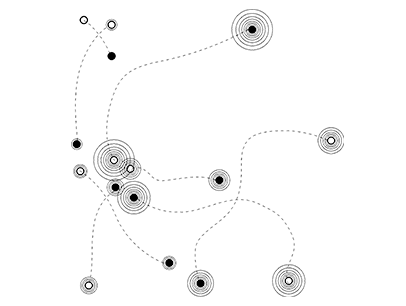Jury Statement
Esalee Andrade-Guerrero dedicates the forty-five symbols of her project “Baile Folklórico” to the folk dances that form parts of the traditions and cultures of different federal states in Mexico. The symbols are subdivided into five regions and each of these consists of a set of nine characteristic signs. At first glance, the signs can be seen as abstract fragments of landscape and geography. But taking a closer look, the dance references become visible and intelligible without being too in your face or banal. In a very subtle and organic approach, Andrade-Guerrero depicts ephemeral moments created through the fluidity of dance. While each symbol represents a single dance, the set in its entirety provides an almost sensory experience of a choreography—almost like a stop-motion sequence that comes to life. Andrade-Guerrero successfully translates cultural gestures, notations, and body language into schematic representations of skirts, and makes the Mexican identity something tangible in this work. She created a cohesive and precise character set that follows a systematic approach and uses a very powerful, expressive, and simple form of language that bridges cultural barriers.
Baile Folklórico
Project description by the author
To become aware of our history is to become aware of our singularity. This idea poses an essential perspective on the state of contemporary Mexican identity. Now more than ever before, there is a need to revive the narrative of power and strength to contest the fragmented and biased view of Mexican people portrayed by many mainstream media outlets and American politics. Baile Folklórico speaks with a language of movement that inspires and represents the regional, national, and personal notions of beauty and culture extending back to the pre-Spanish era of Mexico. Its dramatic choreography tells a tale of humor, religion, loss, and rituals, which are all crucial components to understand the origins of the Mexican identity. To preserve the spirit of, and to keep the true characteristics authentic, it is essential that Mexican heritage lives beyond the past. Through the visual interpretations of movement and form, these 45 symbols weave a map that reveals the various styles and idiosyncrasies that maintain the regional narratives in Mexican culture. By visually expressing the differences in conjunction with the inherent similarities in the structure of Baile Folklórico, there is harmony within the symbols that communicates the ability of the Mexican identity to revive itself as a unified voice.
Esalee Andrade-Guerrero
Esalee Andrade-Guerrero lives in Houston, Texas and studies Graphic Design at the University of Houston. Being born and raised in the fourth largest city in the U.S. has given her meaningful perspectives on the mixing of cultures in urban environments and the inequalities in cultural representation. She believes in responsible and sincere methods of visual communication in design.



